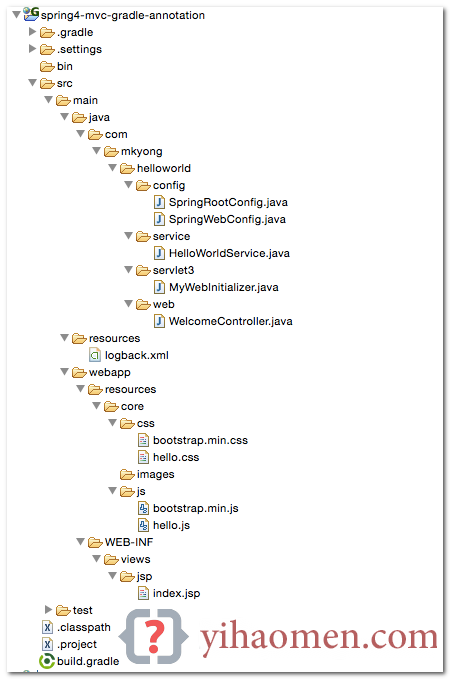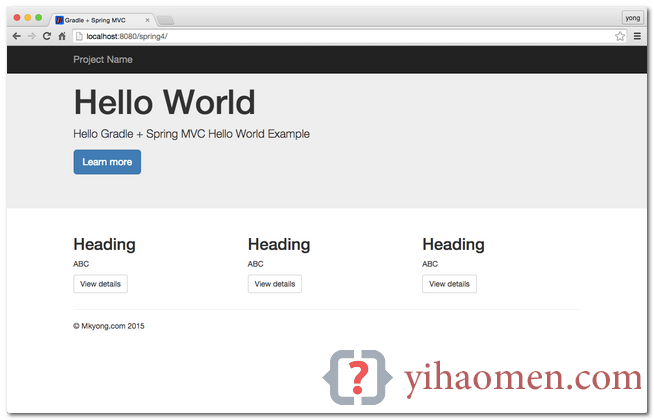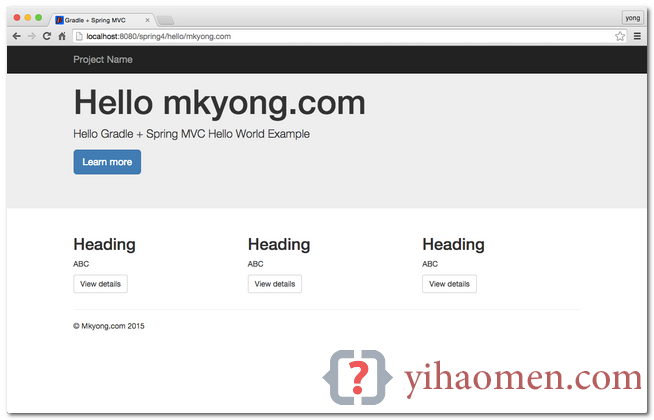Gradle – Spring 4 MVC Hello World Example Annotation

In this tutorial, we will take the previous Gradle + Spring MVC XML example, rewrite it to support @JavaConfig annotation configuration, no more XML files.
P.S This example will works in Servlet 3.0+ container only, like Tomcat 7 or Jetty 9.
Technologies used :
- Gradle 2.0
- Spring 4.1.6.RELEASE
- Tomcat 7 or Jetty 9
- Eclipse 4.4
- JDK 1.7
- Logback 1.1.3
- Boostrap 3
1. Project Structure
Download the project source code and review the project folder structure :

P.S No more XML files like web.xml or Spring XML configuration files.
2. Gradle
2.1 Review the build.gradle file, this should be self-explanatory.
apply plugin: 'java'
apply plugin: 'war'
apply plugin: 'eclipse-wtp'
//apply plugin: 'jetty' //too old, Jetty 6, use gretty plugin
apply plugin: 'org.akhikhl.gretty'
// JDK 7
sourceCompatibility = 1.7
targetCompatibility = 1.7
repositories {
mavenLocal()
mavenCentral()
dependencies {
compile 'ch.qos.logback:logback-classic:1.1.3'
compile 'org.springframework:spring-webmvc:4.1.6.RELEASE'
compile 'javax.servlet:jstl:1.2'
//include in compile only, exclude in the war
providedCompile 'javax.servlet:servlet-api:2.5'
//Gretty Embedded Jetty
buildscript {
repositories {
jcenter()
dependencies {
classpath 'org.akhikhl.gretty:gretty:+'
// Don't use Jetty8, even it's a servlet 3.0+ container,
// but not support non-jar WebApplicationInitializer scanning.
// It will cause "No Spring WebApplicationInitializer types detected on classpath"
gretty {
port = 8080
contextPath = 'spring4'
servletContainer = 'jetty9' //tomcat7 or tomcat8
//For Eclipse IDE only
eclipse {
wtp {
component {
//define context path, default to project folder name
contextPath = 'spring4'
2.2 Make this project supports Eclipse IDE. Now, you can import the project into Eclipse IDE.
your-project$ gradle eclipse
3. Spring @Configuration
Spring @Configuration and its XML equivalent.
3.1 Spring annotation configuration to scan the service classes.
package com.mkyong.helloworld.config;
import org.springframework.context.annotation.ComponentScan;
import org.springframework.context.annotation.Configuration;
@Configuration
@ComponentScan({ "com.mkyong.helloworld.service" })
public class SpringRootConfig {
XML equivalent.
<beans xmlns="http://www.springframework.org/schema/beans"
xmlns:context="http://www.springframework.org/schema/context"
xmlns:xsi="http://www.w3.org/2001/XMLSchema-instance"
xmlns:mvc="http://www.springframework.org/schema/mvc"
xsi:schemaLocation="
http://www.springframework.org/schema/beans
http://www.springframework.org/schema/beans/spring-beans.xsd
http://www.springframework.org/schema/context
http://www.springframework.org/schema/context/spring-context.xsd ">
<context:component-scan base-package="com.mkyong.helloworld.service" />
</beans>
3.2 Extends abstract class WebMvcConfigurerAdapter.
package com.mkyong.helloworld.config;
import org.springframework.context.annotation.Bean;
import org.springframework.context.annotation.ComponentScan;
import org.springframework.context.annotation.Configuration;
import org.springframework.web.servlet.config.annotation.EnableWebMvc;
import org.springframework.web.servlet.config.annotation.ResourceHandlerRegistry;
import org.springframework.web.servlet.config.annotation.WebMvcConfigurerAdapter;
import org.springframework.web.servlet.view.InternalResourceViewResolver;
import org.springframework.web.servlet.view.JstlView;
@EnableWebMvc //<mvc:annotation-driven />
@Configuration
@ComponentScan({ "com.mkyong.helloworld.web" })
public class SpringWebConfig extends WebMvcConfigurerAdapter {
@Override
public void addResourceHandlers(ResourceHandlerRegistry registry) {
registry.addResourceHandler("/resources/**")
.addResourceLocations("/resources/");
@Bean
public InternalResourceViewResolver viewResolver() {
InternalResourceViewResolver viewResolver
= new InternalResourceViewResolver();
viewResolver.setViewClass(JstlView.class);
viewResolver.setPrefix("/WEB-INF/views/jsp/");
viewResolver.setSuffix(".jsp");
return viewResolver;
XML equivalent.
<beans xmlns="http://www.springframework.org/schema/beans"
xmlns:context="http://www.springframework.org/schema/context"
xmlns:xsi="http://www.w3.org/2001/XMLSchema-instance"
xmlns:mvc="http://www.springframework.org/schema/mvc"
xsi:schemaLocation="
http://www.springframework.org/schema/beans
http://www.springframework.org/schema/beans/spring-beans.xsd
http://www.springframework.org/schema/mvc
http://www.springframework.org/schema/mvc/spring-mvc.xsd
http://www.springframework.org/schema/context
http://www.springframework.org/schema/context/spring-context.xsd ">
<context:component-scan base-package="com.mkyong.helloworld.web" />
<bean class="org.springframework.web.servlet.view.InternalResourceViewResolver">
<property name="viewClass" value="org.springframework.web.servlet.view.JstlView"/>
<property name="prefix" value="/WEB-INF/views/jsp/" />
<property name="suffix" value=".jsp" />
</bean>
<mvc:resources mapping="/resources/**" location="/resources/" />
<mvc:annotation-driven />
</beans>
4. Servlet 3.0+ Container
Create a ServletInitializer class, Servlet 3.0+ container will pick up this class and run it automatically. This is the replacement class for web.xml
package com.mkyong.helloworld.servlet3;
import org.springframework.web.servlet.support.AbstractAnnotationConfigDispatcherServletInitializer;
import com.mkyong.helloworld.config.SpringRootConfig;
import com.mkyong.helloworld.config.SpringWebConfig;
public class MyWebInitializer extends
AbstractAnnotationConfigDispatcherServletInitializer {
@Override
protected Class<?>[] getRootConfigClasses() {
return new Class[] { SpringRootConfig.class };
@Override
protected Class<?>[] getServletConfigClasses() {
return new Class[] { SpringWebConfig.class };
@Override
protected String[] getServletMappings() {
return new String[] { "/" };
XML equivalent.
<web-app xmlns="http://java.sun.com/xml/ns/javaee" xmlns:xsi="http://www.w3.org/2001/XMLSchema-instance" xsi:schemaLocation="http://java.sun.com/xml/ns/javaee http://java.sun.com/xml/ns/javaee/web-app_2_5.xsd" version="2.5"> <display-name>Gradle + Spring MVC Hello World</display-name> <description>Spring MVC web application</description> <!-- For web context --> <servlet> <servlet-name>hello-dispatcher</servlet-name> <servlet-class> org.springframework.web.servlet.DispatcherServlet </servlet-class> <init-param> <param-name>contextConfigLocation</param-name> <param-value>/WEB-INF/spring-mvc-config.xml</param-value> </init-param> <load-on-startup>1</load-on-startup> </servlet> <servlet-mapping> <servlet-name>hello-dispatcher</servlet-name> <url-pattern>/</url-pattern> </servlet-mapping> <!-- For root context --> <listener> <listener-class> org.springframework.web.context.ContextLoaderListener </listener-class> </listener> <context-param> <param-name>contextConfigLocation</param-name> <param-value>/WEB-INF/spring-core-config.xml</param-value> </context-param> </web-app>
There is no change in the Spring controller, logback and JSP files, so, the source code will not repeat here, please refer to the previous Gradle + Spring MVC XML example for complete source code.
5. Demo
5.1 To run this project. Issues gradle jettyRun to start the embedded Jetty container.
your-project$ gradle jettyRun 21:56:34 INFO Jetty 9.2.10.v20150310 started and listening on port 8080 21:56:34 INFO spring4 runs at: 21:56:34 INFO http://localhost:8080/spring4 Press any key to stop the server. > Building 87% > :jettyRun
5.2 http://localhost:8080/spring4/

5.3 http://localhost:8080/spring4/hello/mkyong.com

Download Source Code
References
- Wikipedia – Java servlet
- Spring Web MVC References
- Gradle – EclipseWtp
- Gradle – Eclipse Plugin
- Gradle – Jetty Plugin
- Gradle – Gretty plugin
- Gradle – Gretty configuration
From:一号门
Previous:Maven Jetty Plugin Examples

COMMENTS